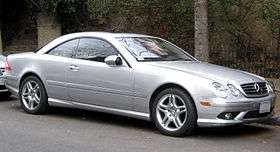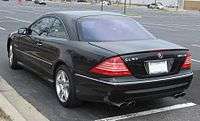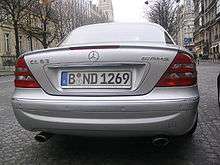Mercedes-Benz CL-Class (C215)
The second generation of the Mercedes-Benz CL-Class is the C215-chassis coupé of 1998–2006. It is based on the 1998–2005 Mercedes-Benz S-Class (W220), though it rides on an 8-inch (203 mm) shorter wheelbase. Sales in Germany started in August 1999 for the CL 500 V8.
| Mercedes-Benz C215 | |
|---|---|
 | |
| Overview | |
| Manufacturer | DaimlerChrysler |
| Production | June 1998–February 2006 |
| Assembly | Germany: Sindelfingen |
| Designer | Peter Arcadipane, Bruno Sacco (1995) |
| Body and chassis | |
| Class | Grand tourer (S) |
| Body style | 2-door coupé |
| Layout | Front-engine, rear-wheel-drive |
| Related | Mercedes-Benz W220 |
| Powertrain | |
| Engine | |
| Transmission |
|
| Dimensions | |
| Wheelbase | 2,885 mm (113.6 in) |
| Length | 4,989–4,993 mm (196.4–196.6 in) |
| Width | 1,857 mm (73.1 in) |
| Height | 1,398–1,408 mm (55.0–55.4 in) |
| Curb weight | 1,865–2,155 kg (4,112–4,751 lb)[1] |
| Chronology | |
| Predecessor | Mercedes-Benz C140 |
| Successor | Mercedes-Benz C216 |
The C215 exterior design and active suspension was previewed by the Mercedes-Benz F200 concept in 1996.
The CL-Class is offered as seven models: the V8-powered CL 500, the V8 powered naturally aspirated CL 55 AMG, the supercharged V8-powered CL 55 AMG, the V12-powered CL 600, a limited-edition V12-powered CL 63 AMG, and the bi-turbo V12-powering the CL 600 bi-turbo and the CL 65 AMG. All models seat four. Exterior design produced a drag coefficient of Cd=0.28[2] for a regular models and 0.29 for AMG.
Features and equipment
_coupe_(16516635269).jpg)
_coupe_(16515381730).jpg)
The CL-Class coupés come equipped with the very latest in Mercedes-Benz technology, and along with the S-Class sedans the CL coupés receive new technological features.
C215 was the second car (after the W220 S-Class) with Distronic: the first worldwide radar-assisted Autonomous cruise control system. It was the first car in the world with both low beam and high beam (Bi-Xenon) High Intensity Discharge headlamps.
The C215 was standard equipped with the hydraulic Active Body Control (ABC) system. It is technically more advanced than standard Airmatic air suspension found on the W220 S-Class sibling, and keeps the car level even in fast corners, provides a comfort and sports setting. Also, the car height can be increased by using a button, increasing ground clearance (3 settings) for driving on difficult terrain, lowers automatically at higher speeds.
From 1999 through 2003, the V12-equipped cars featured a cylinder deactivation system called Active Cylinder Control. The feature was dropped when the 500 PS (368 kW; 493 hp) bi-turbo V12 was introduced. This disactivation feature allowed the CL 600 to get better fuel economy than the comparable CL 500 (when not equipped with ACC itself, an option for the V8), especially on the road where the six-cylinder operation could be effectively used. Essentially, the engine is two Mercedes six-cylinder series engines mated to a common crank with separate engine monitoring systems.
Safety
.jpg)
In 2003, the cars were upgraded with Pre-Safe precrash system and a newer electronics package that included a DVD-based navigation system instead of the CD-based COMAND system. Also, the engine options changed. The CL 55 AMG became supercharged allowing the car to accelerate from 0-60 mph in 4.27sec according to Motor Trend and the V12 CL 600 had turbochargers added and a slight engine reduction, from 5786 cc to 5513 cc. Both cars produced 500 PS (368 kW; 493 hp) the distinction, again, was the quietness of the CL 600 as compared to rather noisy CL 55 AMG. The more powerful CL 65 produced 612 PS (450 kW; 604 hp). The top speed of the car was limited to 250 km/h (155 mph).
Electronic Stability Program (ESP) and Brake Assist were standard features for difficult driving conditions and emergency maneuvers.
The C215 CL-Class added standard front and rear side curtain airbags. In total, the C215 features 8 airbags: 2 frontal (driver and passenger), 4 side airbags (one for each passenger, optional for rear seats) and 2 window-airbags.
LED brake lights were also standard issue on the C215. LED brake lights illuminate faster than conventional bulbs.
Comfort and convenience


- Distronic cruise control, which could maintain a set distance between the CL-Class and any vehicle in front.
- Speedtronic adjustable speed limiter for not exceeding a set speed on roads with speed limits.
- Keyless Go, a smart key entry and startup system.
- Rain-sensing windshield wipers.
- Light sensors to turn the headlights on and off automatically, depending on lighting circumstances. The instrument display and the COMAND screen's backlight and colour also adjust automatically depending on the ambient light situation.
- Parktronic visual and audible parking aid, with sensors in the front and rear bumpers. Also, the passenger side mirror can swivel down automatically when engaging reverse, to help see the curb.
- Automatically heated exterior mirrors.
- Fully automatic climate control system with pollen and charcoal filters and optional separate rear-seat climate controls.
- COMAND system combines the controls for audio systems, the television, the navigation and the telephone. COMAND based cars offer higher quality audio compared to the Audio 10 system.
- Optional BOSE sound system.
- Summer Open/Close - Ability to open and close all four windows and the sunroof at the sametime upon entry and/or exit from the vehicle.
- Self opening and closing trunk.
- Self-closing doors.
- Electrically adjustable seats are standard. Optional were the memory function for the seats (standard in many countries on the larger engine models) and the multi-contour backrests with massage function.
- Easy entry/exit function.
- Auto-dimming interior and driver's side exterior rear view mirrors to prevent being dazzled by cars behind.
- bi-xenon headlamps
- Linguatronic voice recognition system which can be used to control the audio system, navigation system, and a cellular telephone through voice commands.
Limited Editions

The CL 63 AMG is the rarest C215 CL-Class of all. It was produced only in November 2001, presented at Frankfurt International Motor Show same year and just 26 examples were ever built for sale.[3] Each car cost €272,000 when new. Some UK examples were registered in March 2002. The V12-powered CL 63 AMG was only sold in Europe and Asia. Mercedes-Benz never offered the C215 CL 63 for sale; all were sold exclusively through AMG. Its naturally aspirated V12 engine developed 326 kW.[4]
In 2000 Mercedes-Benz presented CL 55 AMG F1 Limited Edition model. With production limited to only 55 numbered examples, cars sported lighter carbon-ceramic brake discs with special eight-piston Brembo calipers. Model was based on a standard naturally aspirated CL 55 AMG with identical performance values but better stopping power. Available only in metallic silver with black and silver leather interior with an option of sports bucket seats. F1 Limited Edition logos can be found on an illuminated door sills and on a carbon-fibre finished centre console along with a series number.[5]
Engines
As with all major German manufacturers (except Porsche) Mercedes electronically limits their cars to 250 km/h (155 mph).
| Model | Engine | Power | Torque | 0–100 km/h (62 mph) |
Top speed | CO2 emissions g/km |
|---|---|---|---|---|---|---|
| CL 500 | 5.0 L V8 M113 | 225 kW (306 PS; 302 hp) at 5600 rpm | 460 N⋅m (339 lb⋅ft) at 2700–4250 rpm | 6.5 seconds | 250 km/h (155 mph) | 285–320 |
| CL 600 | 5.8 L V12 M137 | 270 kW (367 PS; 362 hp) at 5500 rpm | 530 N⋅m (391 lb⋅ft) at 4250 rpm | 6.3 seconds | 250 km/h (155 mph) | 321 |
| CL 600 (from 2002) |
Twin-turbocharged 5.5 L V12 M275 |
368 kW (500 PS; 493 hp) at 5000 rpm | 800 N⋅m (590 lb⋅ft) at 1800–3500 rpm | 4.8 seconds | 250 km/h (155 mph) | 353 |
| CL 55 AMG | 5.4 L V8 M113 | 265 kW (360 PS; 355 hp) at 5500 rpm | 530 N⋅m (391 lb⋅ft) at 3150–4500 rpm | 6.0 seconds | 250 km/h (155 mph) | 310 |
| CL 55 AMG (from 2002) |
Supercharged 5.4 L V8 M113 |
368 kW (500 PS; 493 hp) at 6100 rpm | 700 N⋅m (516 lb⋅ft) at 2750–4000 rpm | 4.8 seconds | 250 km/h (155 mph) | 317 |
| CL 63 AMG | 6.3 L V12 M137 | 326 kW (443 PS; 437 hp) at 5500 rpm | 620 N⋅m (457 lb⋅ft) at 4400 rpm | 5.5 seconds | 250 km/h (155 mph) | 338 |
| CL 65 AMG | Twin-turbocharged 6.0L V12 M275 |
450 kW (612 PS; 603 hp) at 4800–5100 rpm | 1,000 N⋅m (738 lb⋅ft) at 2000–4000 rpm | 4.4 seconds | 250 km/h (155 mph) | 357 |
Production
According to Daimler,[6] the C215 was produced in the following numbers:
- CL 500 (1998-2006) - 32,224
- CL 600 (1998-2002) - 6,348
- CL 600 (2002-2005) - 2,255
- CL 55 AMG (2000-2002) - 2,217
- CL 55 AMG (2002-2005) - 4,163
- CL 63 AMG (2001) - 26
- CL 65 AMG (2003-2005) - 777
Total production of the C215 CL-Class was 47,984 units (excluding 63 AMG model).
References
- "215 series CL-Class Coupés". mercedes-benz-publicarchive.com. Retrieved 5 September 2018.
- "Technical highlights of the CL-Class and its predecessor series". media.daimler.com. Retrieved 30 August 2019.
- "2003 Mercedes-Benz CL63 AMG". bonhams.com. Retrieved 20 September 2019.
- "C 215 series (1999 to 2006)". media.daimler.com. Retrieved 20 August 2019.
- "2000 Mercedes-Benz CL55 AMG F1". supercars.net. Retrieved 5 September 2018.
- "Production figures C 215 series". media.daimler.com. Retrieved 30 August 2019.